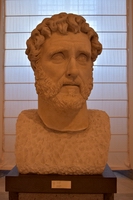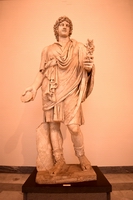MANN - Piano Terra - Collezione Farnese - sala XIV

Antonino Pio
|

Lare Farnese
|
Antonino Pio
inv. 6078 post 161 d.C.
La testa, che originariamente era inserita in un busto antico lavorato a parte, è stata identificata con quella che le fonti cinquecentesche indicano come proveniente dalle Terme. L'immagine è vicina al tipo Formia, che costituisce il ritratto ufficiale di Antonino Pio imperatore per tutta la prima metà del suo regno (138-161 d.C.). Tuttavia le dimensioni colossali fanno attribuire questa opera ad un monumento celebrativo dell'imperatore, divinizzato dopo la morte. A palazzo Farnese era collocata nella loggia verso via Giulia, in una delle nicchie ovali sopra le porte.
Antoninus Pius
Inv. 6078 post AD 161.
This head was originally set in an ancient bust that had been made separately. It has been identified as the head that 16th century sources record as having come from the Baths. Its features are similar to those of the ‘Formia-type’, which was the official portrait of the emperor Antoninus Pius for the entire first half of his reign (AD 138-161). The colossal size of the head suggest the statue belonged to a monument memorializing the emperor, who was deified after his death. In the Palazzo Farnese, the head was placed in the loggia overlooking Via Giulia, in one of the oval niches above the doors.
cd. Lare Farnese
inv. 5975 Creazione romana, II secolo d.C.
La statua rappresenta un giovane dai tratti ideali, vestito di tunica corta e mantello drappeggiato ai fianchi, con una patera nella mano destra; i fiori nella mano sinistra sono un'integrazione di Carlo Albacini. La foggia dell'abito, forse una trabea, ed il tipo di calzari consentono la sua identificazione con un Genio, spirito tutelare e vitale dell'uomo romano, che esercita la propria benefica influenza su ogni aspetto ed istituzione della società romana. Esiste infatti il genius familiaris, protettore della famiglia, ed il genius populi romani, che sorveglia e accompagna la vita di tutto il popolo romano. Per estensione delle sue competenze il genio è anche nume tutelare di luoghi, istituzioni ed associazioni. Dal culto familiare del genio deriva il culto del genio dell'imperatore (genius Augusti), una forma di travestimento di venerazione dell'imperatore ancora vivente. A questo motivo si lega in particolare il successo dello schema iconografico. Data l'eccezionalità delle dimensioni la statua, databile al II sec. d.C., proviene certamente da un importante edificio pubblico.
La provenienza dalle Tenne, sostenuta da alcuni studiosi, si basa sulla presenza, su uno stesso foglio della raccolta di disegni di Maarten van Heemskerck, della statua e di una veduta del complesso. Tuttavia la datazione dei disegni romani di quest'artista - di più di dieci anni anteriori agli scavi di Paolo III - nonché altri schizzi, in cui la statua è chiaramente riconoscibile nel giardino di villa Madama, proprietà di Margherita d'Austria, portano ad escludere tale provenienza.
The so-called Farnese Lar
inv. 5975 Roman creation, 2nd century AD
This statue depicts a idealized youth, dressed in a short tunic with a cloak draped over his side, holding a patera in his right hand. The flowers in his left hand are a restoration by Carlo Albacini. The nature of his clothing, perhaps depicting the toga-like garment known as a trabea, and the type of shoes he wears allow us to identify him as a Genius, a protective and vital spirit of the Romans, who exercised his benign influence over every aspect and institution of their society. There was the genius familiaris, protector of the family, and the genius populi romani, who oversaw and accompanied every aspect of the life of the Roman people. By extension of his responsibilities, the genius also became a protective spirit of places institutions and associations. The cult of the genius of the emperor (genius Augusti), providing a guise under which a living emperor might be worshipped, developed from the family cult of the genius. The frequency with which this iconographic scheme was employed relates to this association with the emperor.
Given the exceptional size of this statue (which can be dated to the 2nd century AD), it must come from an important public building. The view that it carne from the Baths of Caracalla is one upheld by many scholars, and is based on the fact that a single page of the collected drawings of Maarten van Heemskerck has both a depiction of this statue and a view of the Baths. Nevertheless the dating of this artist's Roman drawings - more than ten years before Paul III's excavations -and other sketches that clearly show the statue in the garden of the Villa Madama, the property of Margaret of Austria, and tend to rule out the Baths as the statue's provenance.
Fotografie di Giorgio Manusakis
